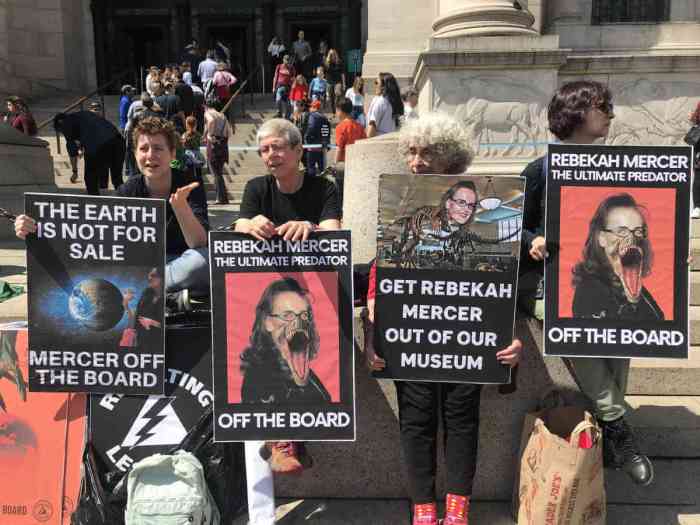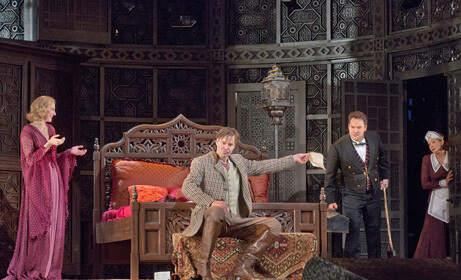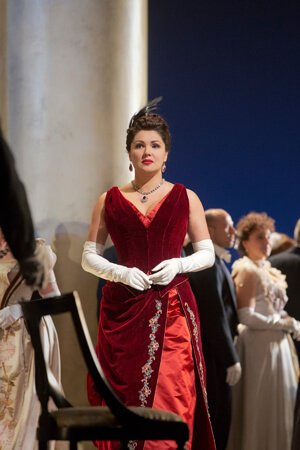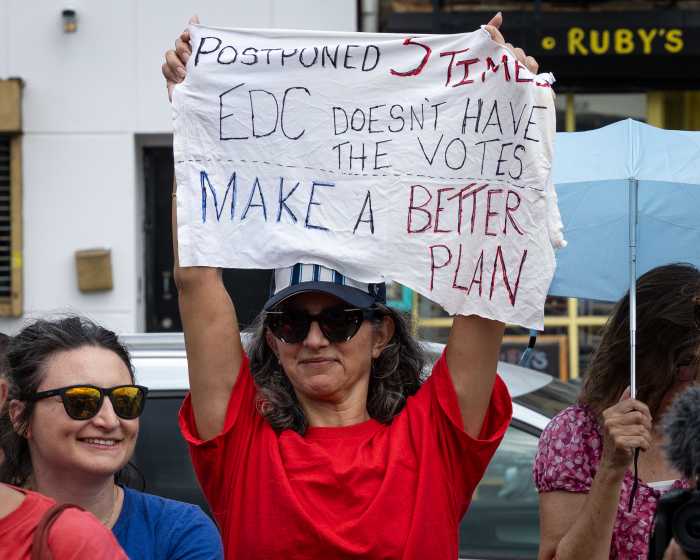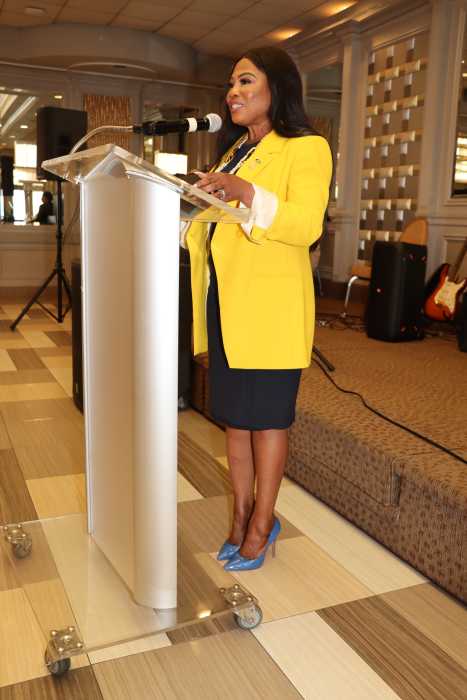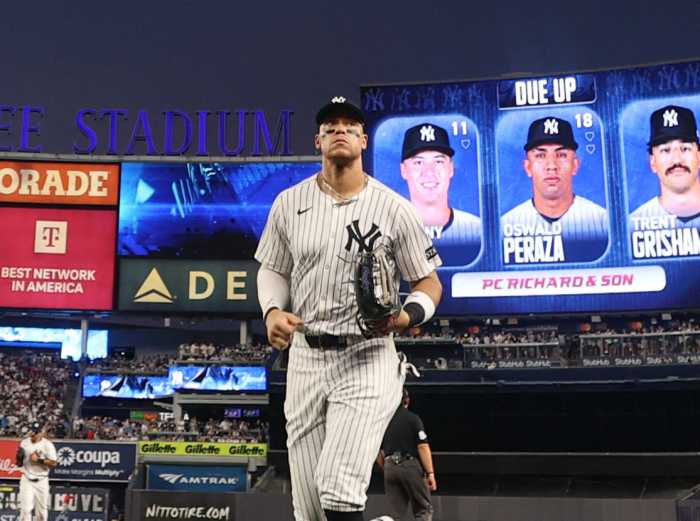Jennifer Zetlan in the On Site Opera production of John Musto and Eric Einhorn’s “Rhoda and the Fossil Hunt” at the American Museum of Natural History. | DAVID ANDRAKO
The year 2018 will mark Leonard Bernstein’s centenary, so expect multiple unveilings of his music theater pieces. The Philadelphia Orchestra’s welcomely out Canadian maestro Yannick Nézet-Séguin, in pec-flaunting casual clothes, led off the celebration October 12 with a concert staging of “West Side Story.” The edition cut much dialogue and several non-singing characters and, though Kevin Newbury’s blocking was logical, anyone not knowing the show coming in might have been lost.
But who doesn’t know “West Side Story?”
The orchestra — which played the dynamic, thieving magpie-sourced score under a restored print of Robert Wise’s film a few years back — sounded terrific, with the percussion and brass really rocking out. Their work under Nézet-Séguin was the evening’s point.
Philly’s “West Side,” Divine Devieilhe, Diverting Dinos
Yet there were some strong performances among the cast, mostly music theater people but a few with operatic training, too. The biggest classical name was Isabel Leonard, sounding quite splendid as Maria and acting very naturally — the most characterful work I’ve heard from her since her Juilliard days. With a unified, strong high belt and a dynamic presence, Isabel Santiago did full justice to Anita, and the experienced Zachary James (Action) put over “Gee, Officer Krupke” with real panache. Nora Schell (Rosalia) and Mikaela Bennett (Consuelo) also shone.
Ryan Silverman may have been a fine Tony some years back but it no longer sits flatteringly in his voice; though he phrased with care, the tone often sounded narrow and strained, making a weak match for Leonard’s refulgence.
Going against the traditions of the song “Somewhere” — originated by Reri Grist in 1957, taken by Harolyn Blackwell in 1980s Broadway revival, and by Julia Bullock in San Francisco Symphony’s first-ever-authorized “WSS” concert — this redemptive anthem was mystifyingly awarded to Morgan James, white, blonde, dressed in white as if a visiting angel rather than a member of the urban community portrayed. She started with oratorio purity but faltered as she progressed. But the score, the orchestra playing, and the two Isabels made the evening rewarding.
On October 1, the Park Avenue Armory’s excellent recital series in the ornate Board of Officers Room continued with a terrific New York debut by soprano Sabine Devieilhe and pianist Anne Le Bozec. Both Frenchwomen showed interpretive and technical mastery as well as individual, sonorous timbres — all wedded to that ineffable quality, genuine charisma. They also demonstrated expert partnering in an intriguing and well-constructed program. Such qualities are rare enough in any vocal recital, let alone a first appearance in New York City before a discriminating “industry” public.
The afternoon was crafted around the legacy of Pauline Viardot-Garcia, the remarkable singer, composer, teacher, and salon hostess who knew every major European cultural figure during her long life (1821-1910) and created and previewed music for many major composers of several generations. Devielhe and Le Bozec performed several of her own compositions (“Seize ans” and “Berceuse cosaque” particularly affecting) as well as works by composers from Bellini, Meyerbeer, and Berlioz through Hahn, Massenet and (in encores) Debussy — with all of whom Viardot-Garcia was linked as exponent, creatrix, or advising muse. The groupings were well devised, with a pair of arias (the showy “Ombre legere” from “Dinorah” and Manon’s engaging “Je suis encore toute etourdie”) in among the French melodies, Italian canzone, and German Lieder.
Devielhe’s soprano is fresh, wide-ranging and — perhaps due to her baroque training — exceptionally good about staying on pitch. Though her German emerged very lightly accented, the command of sung French proved a constant joy, with virtually every word clear and meaningful even at register extremes. Why Devielhe isn’t already in the Met’s line-up is puzzling, as she seems made for the age of HD. One hopes she returns soon, onstage and also with the deft, style-sensitive Le Bozec. The soprano spoke charmingly to her auditors (hardly a foregone conclusion in recitals these days, where many strive unduly for “just folks” over-sharing). She needn’t have worried that we knew who Viardot-Garcia was, as others — including Stephanie Blythe — have offered such programs, plus the fact that as a girl this remarkable figure lived in New York, where the Garcia family introduced many Italian operas to the city, hosted by Mozart’s librettist Lorenzo da Ponte, by then a professor at Columbia.
Devielhe has film star looks — I thought of Jennifer Lawrence since an appealing intelligence is part of the mix — but unlike many so-called “total package artists” doesn’t rely on them. The musicianship and vocalism are equally noteworthy.
The ever-industrious troupe On Site Opera brought a delightful 25-minute opera to the beloved site of the American Museum of Natural History’s iconic T-Rex and Apatosaurus. “Rhoda and the Fossil Hunt,” with a pleasant, upbeat score by John Musto set with characteristic skill to a charming text by Eric Einhorn (who also directed keenly), “Rhoda” enjoyed a three-week run. Heard September 29, it emerged one of the happiest and best crafted site specific-operatic events I’ve seen.
Eight- year-old Rhoda Knight Kalt visits and aids her grandfather Charles R. Knight, the painter who created such memorable canvases of dinosaurs. (I had a postcard of the Apatosaurus in my childhood bedroom; if you’re a native New Yorker you probably did too.) The show was entertaining, informative, and considerately paced and calibrated for adults and children alike.
The petite Met soprano Jennifer Zetlan was wonderful as the bright enthusiastic Rhoda, totally convincing in channeling girlish gestures and energy to keep the kid-filled crowd focused and happy. She made much of her text clear even when it lay high — not a musical or vocal problem for Zetlan, whose instrument blossoms at the top, but a consequence of the resonance in the (perforce) high-ceilinged Hall of Saurischian Dinosaurs. The room’s acoustics were easier on bass-baritone Robert Orth, the theatrically savvy originator of so many contemporary roles, sounded healthy and deployed his exceptional diction to maximize his lively characterization of illustrator Knight. Patrick Cook sported the right Edwardian look for the paleontologist (and museum president) Dr. Henry Fairfield Osborn, who waxed excitement as his forthright tenor pealed forth a dance tune about scientific evidence. Known for good work at the Manhattan School of Music and elsewhere, conductor Jorge Parodi miraculously kept balance going between the singers and an ace ensemble of string quartet, flautist, and clarinet; they too moved around as the opera’s focus shifted. “Rhoda” moves on to museums in Chicago and Pittsburgh; alert kids there should watch for it.
David Shengold (shengold@yahoo.com) writes about opera for many venues.


